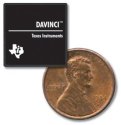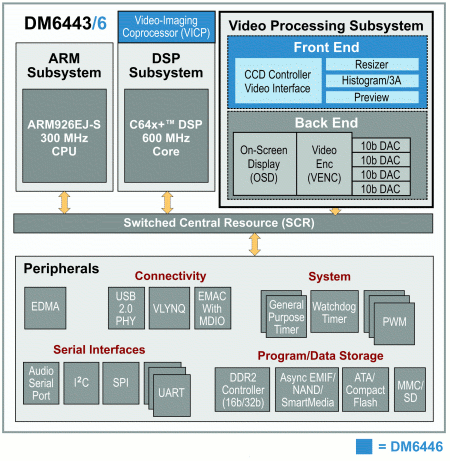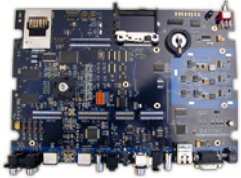Linux drives next-gen video gadget chip
Dec 5, 2005 — by LinuxDevices Staff — from the LinuxDevices Archive — 13 views Texas Instruments (TI) has teamed up Linux with two new highly-integrated system-on-chip (SoC) processors aimed at next-generation portable multimedia players (PMPs), digital video recorders (DVRs), and other video-oriented consumer devices. The TMS320DM6443 and TMS320DM6446 (DM644x) are the first of TI's “daVinci” line, and are available with a full-featured development board and MontaVista Linux/tools support bundle.
Texas Instruments (TI) has teamed up Linux with two new highly-integrated system-on-chip (SoC) processors aimed at next-generation portable multimedia players (PMPs), digital video recorders (DVRs), and other video-oriented consumer devices. The TMS320DM6443 and TMS320DM6446 (DM644x) are the first of TI's “daVinci” line, and are available with a full-featured development board and MontaVista Linux/tools support bundle.
TI announced the daVinci line in September, saying the chips would combine ARM RISC cores with its newest DSP cores, formerly available only as separate coprocessors. It also said it would deliver an unprecedented level of hardware/software integration with the chips, including complete operating systems, tools, and ready-made “software frameworks” that had been “previously built by OEMs.”
Linux is currently the most prominent embedded operating system in DVRs, having been used by DVR pioneer TiVo to power its consumer devices since 1999. TiVo claims to be the leader in DVR market share, with over 3.5 million subscriptions. Linux is also used in numerous other consumer audio/video devices, including the recently introduced Archos PMA400 PMP and the Nokia 770 multimedia-enabled Web tablet.
The TMS320DM6443 and TMS320DM6446
The two new dual-core SoCs incorporate both ARM/RISC and VLIW/DSP (very long instruction word digital signal processor) cores. The TMS320DM6443 targets video decoding applications, such as PMPs, while the TMS320DM6446 targets video transcoding applications, such as DVRs and videoconferencing equipment.

daVinci DM644x architecture diagram
(Source: TI)
The daVinci SoCs include little-endian ARM926EJ-S cores clocked at 297MHz. The cores support 16-bit Thumb instructions, to save power and memory, as well as DSP instruction extensions. They integrate Jazelle Java acceleration engines, a “single-cycle MAC” (multiply-accumulate device), and “EmbeddedICE-RT” logic for real-time debugging, TI says.
Both daVinci SoCs also incorporate a C64x+ DSP core, clocked at 594 MHz. The DSP core has eight functional units, including six 32-/40-bit ALUs (arithmetic logic units), each of which supports up to four 8-bit results per cycle (or a single 32-bit result), and two multipliers, each of which supports up to four 32-bit results (four 16 x 16-bit multiplies) per cycle. Like the ARM9 core, the C64x+ supports compact 16-bit instructions. It is also “byte-addressable” with 8-, 16-, 32-, or 64-bit data, TI says.
The C64x+ core has previously been available in TI's C6000 line of standalone DSP chips — some of which are actually powerful enough to run Linux all by themselves, when used with technology such as that available from Jaluna or Softier.
Along with their RISC and DSP cores, the two daVinci SoCs integrate video processing subsystems (video output only, in the case of the DM6443), external memory interfaces, flash memory card interfaces, 10/100 Ethernet MACs with MII, ATA/ATAPI interfaces, 64-channel DMA controllers, USB port with integrated 2.0 PHY, an I2S audio serial port with AC97 (music) and AIC12 (voice) codecs and SP/DIF assist, an on-chip ARM ROM bootloader, separate power-management controllers for the RISC and DSP cores, VLYNQ FPGA (field-programmable gate array) interfaces, and various timers, watchdogs, and digital I/O lines.
Linux BSP frees developers from low-level chores
TI says it partnered with MontaVista early on to ensure that a Linux OS would be available for the daVinci SoCs concurrent with samples and development boards. Huy Pham, product marketing manager of DSP SoCs, said, “The consumer electronics market dictates that we focus first on the Linux OS. MontaVista Linux made the most sense, because customers perceive it as the market leader. Our customers also say they like MontaVista's royalty-free licensing model.”
Pham says TI and MontaVista worked together to create a Linux BSP that could simplify development, and especially development associated with DSP programming. “There are a lot more ARM/Linux programmers than DSP programmers out there,” he stated.
For example, the combined TI/MontaVista offering comes with a communications mechanism for ARM- and DSP-resident processes. And, the DSP core comes pre-programmed with a “DSP Link FC” microcode layer that has been pre-integrated with MontaVista-developed Linux device drivers. MontaVista's drivers are based on video4Linux and OSS frameworks, making it easier to integrate commodity image capture and audio chipsets, Pham said.
The daVinci DM644x software stack includes an IPC layer and generic DSP BIOS firmware layer
(Click image for imager view)
Of course, the DSP BIOS layer is also completely reprogrammable, for customers with special needs, and the required tools and capabilities, Pham stated.
Codecs, too
Additionally, TI says it has created a variety of codecs for the new daVinci SoCs, including H.264, various MPEG-4 codecs, and more. Watermarked and/or audible-tone codecs are shipped with the development board, for user testing, with fully functional versions available to holders of the appropriate licenses.
 DVEVM development kit
DVEVM development kit
TI is offering a comprehensive hardware/software DVEVM development kit to support designs based on the daVinci SoCs.
The kit includes:
- A development board, based on the DM6446 (pictured at right)
- Codec evaluations and demos
- Multimedia APIs and frameworks
- MontaVista's 2.6.10 kernel-based Linux support package
- Sample applications with source code
- An NTSC/PAL video camera
- A 5.6-inch LCD screen
- Speakers and a microphone
- An IR remote
- A 2.5-inch 40GB hard drive
- Reference guidelines for high-speed video board design and layout
Interfaces implemented on the board include USB 2.0, 10/100 Ethernet, NTSC/PAL video input, NTSC/PAL and YPbPr/RGB video output, CD-quality audio input and output, and CompactFlash and SD card interfaces. There are also daughter-card connections to peripheral interfaces, according to TI.
One demo codec not included in the DVEVM is VC1, a superset of the codec used with Microsoft's WM9 format. However, VC1 codecs for the DM6446 and DM6443 are available from TI, a company spokeswoman said.
Availability
The TMS320DM6443 and TMS320DM6446 are sampling now, and are expected to be priced around $30 and $35, respectively, in OEM volumes, when they reach full production in 2006.
The DVEVM development kit (P/N TMDXEVM6446) is available with an 8-week lead time, priced at $2,000, according to TI.
Pham declined to comment on early daVinci customers, but did say he expects “five of the top eight videophone manufacturers” to use the chip.
Greg Mar, platform manager of DSP SoCs at TI, stated, “MontaVista Pro provides a proven and tested embedded Linux offering that simplifies digital video innovation.”
MontaVista's VP of marketing, Peder Ulander, added, “TI understands the importance of providing customers with open, flexible and easy-to-use solutions.”
This article was originally published on LinuxDevices.com and has been donated to the open source community by QuinStreet Inc. Please visit LinuxToday.com for up-to-date news and articles about Linux and open source.
